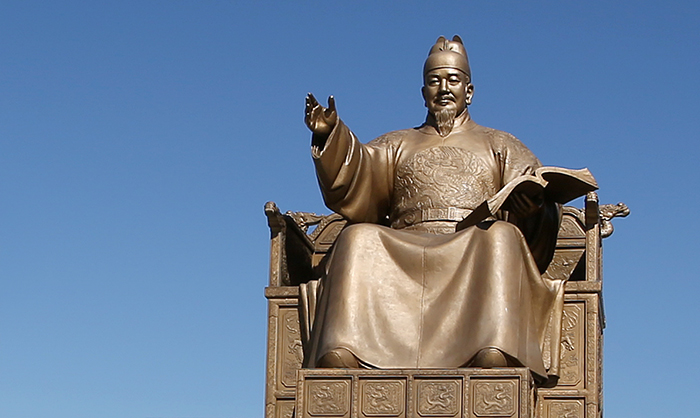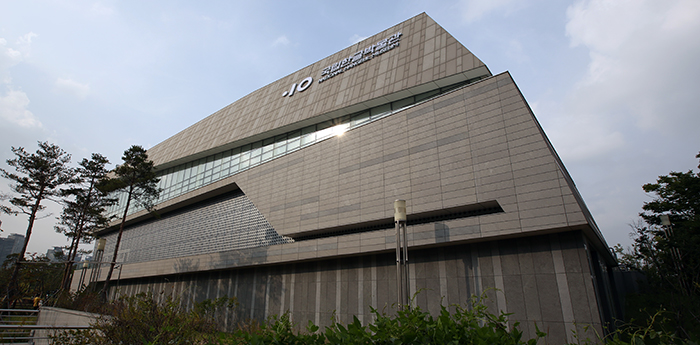
The statue of King Sejong who invented Hangeul alphabet
By Korea.net Honorary Reporter Esraa Elzeny from Egypt
Photos = Korea.net DB
Korean is the official language of both North and South Korea, and it's spoken by more than 80 million people around the world.
One of the features of the Korean language is that it's one of the few languages that was known to its main creator, King Sejong the Great (r. 1418-1450). What is the story of the invention of Korean and why was it created? Many such questions can be answered at the Hangeul Museum, which opened in 2014 to introduce the Korean language. So let's take a tour of this great museum.
The Hangeul alphabet is the official writing system for the Korean language. Its creation was overseen by scholars working under King Sejong. Before the creation of the Hangeul alphabet, Korean was written using traditional Chinese characters, called Hanja in Korean. However, only the men in government and the royal family was taught how to write the characters.
King Sejong, who is said to have loved all of his subjects no matter what their social status, wanted them all to be able to write. He, along with his advisers, created a written alphabet called Hangeul. The Hangeul letters were supposedly based on how the mouth, tongue and lips are shaped when making certain consonant or vowel sounds. The idea of writing the letters thusly may seem simplistic, but historians claim that no other writing system is like Hangeul, and that it's one of a kind.
It's good to visit to the National Hangeul Museum where you can find all that you need to learn about Hangeul, and there is no admission fee, either!
The museum itself is an amazing mix of modern technology showcasing traditions and history that you can explore with three senses: the eyes, ears and mouth.

You can learn more about the Korean alphabet at the National Hangeul Museum.
On the first floor you can find the Hangeul Library. The library has books related to the script and the language, all designed to share the linguistic value of the Hangeul alphabet with the public. Visitors can also check out books about heritage, traditions, the arts and children’s stories.
The second and third floors compose more of the Hangeul alphabet exhibits, where both locals and visitors can appreciate the wonders of this writing system. Exhibits range from the historical aspects of the writing system down to modern applications in today’s bustling, globalized Korea.
The Permanent Exhibition Hall takes up the entire second floor and the hall showcases the historical and modern value of the Hangeul alphabet, from its invention down to the present use of the writing system. The exhibited items are carefully selected and presented to help visitors understand the various uses of the alphabet in communication, education, religion, the arts, publishing and technology.
The Special Exhibition Hall features artifacts and artworks from the past and the present. The exhibitions unveil the fascinating history of the Hangeul writing system and explore its countless innovations and uses in today’s rapidly changing world.
The Hangeul Activity Hall is mainly for children or adults young at heart, but should beginner-level Korean learners come here, it's also a good place to learn the basics of Hangeul and how to express yourself in Hangeul through easy but interactive fun.
The Hangeul Discovery Hall can help non-Korean visitors further their understanding of Hangeul through modern technology. It includes exhibitions and learning experiences, one of which includes a phonetic exhibit that can help master the correct pronunciation of the vowels and consonants.
The museum also offers facilities for parents of infants, with a nursing room for when they need to give their attention to their babies, and wheelchairs and strollers are available so that disabled or younger children can access the whole museum. If you’re also feeling peckish, food and drinks are available in the museum café, along with the shop if you ever want to buy some souvenirs or memorabilia.
To get to the National Hangeul Museum, it's right next to the National Museum of Korea on subway line No. 4 at Ichon Station.
Whether you’re new to Hangeul or have been learning the language for many years, I highly recommend that you visit the museum to truly immerse yourself in the historical and modern adventure of this unique writing system.
wisdom117@korea.kr
* This article is written by a Korea.net Honorary Reporter. Our group of Honorary Reporters are from all around the world, and they share with Korea.net their love and passion for all things Korean.